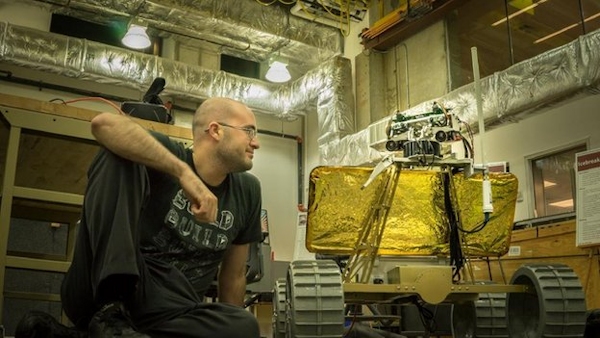[From BBC News; an impressive 1:36 minute video is available on YouTube]
[Image: Daniel Shafrir hopes Andy can transform education about space]
Robot will beam live Moon pictures to Oculus users
By Jane Wakefield, Technology reporter
21 October 2014
Scientists at Carnegie Mellon University have developed a robot which they plan to land on the Moon to act as eyes for Earth-bound space enthusiasts.
The project is part of a $30m prize from Google offered to a team that can send video back from the moon.
The robot has already been shown to potential investors, including Apollo 9 astronaut Rusty Schweickart.
It works in tandem with an Oculus Rift virtual reality headset.
The scientists from Carnegie Mellon have teamed up with space firm Astrobotic to compete for the Google Lunar XPrize, which requires a team to land a robot on the Moon, move it 500m and send back video to Earth.
Astrobotic Technology, which is a spin-off from Carnegie Mellon, is planning on flying with SpaceX – the private space company set up by Elon Musk – using its Falcon 9 rocket to launch the robot. It is hoped that the rocket will take off at the end of 2015.
Non-stop hackathon
“The vision was simple – let anyone on Earth experience the Moon live through the eyes of a robot,” explained team leader Daniel Shafrir.
“We weren’t just going to go to the Moon. We are going to bring the Moon back,” he added.
The telepresence robot, nicknamed Andy after university founder Andrew Carnegie, can be controlled by an operator’s head.
Using an Oculus Rift headset, the movements of the user’s head are tracked and sent back to Andy’s camera so that it will match where the user is looking.
“Imagine the feeling of looking out and seeing rocks and craters billions of years old. Turn your head to the right and you see the dark expanse of space. Turn your head to the left and you see home, Earth,” said Mr Shafrir.
To achieve this required complex coding. The team also encountered smaller problems such as the fact that the Oculus software was unable to receive two live video streams at the same time.
“Tackling challenges like that made the project a non-stop, day and night hackathon,” explained Mr Shafrir.
Working with games designer Ben Boesel and planetarium director Dan Arnett, the team put Andy through his paces in a demo earlier this month.
The vision is to have “hundreds of the robots on the Moon”, said Mr Shafrir.
“With an Oculus headset in every classroom, allowing kids to experience what, to this date, has only been experienced by 12 human beings,” he added.
There are currently 18 teams from around the world competing to win the Google-sponsored Lunar X-Prize.
